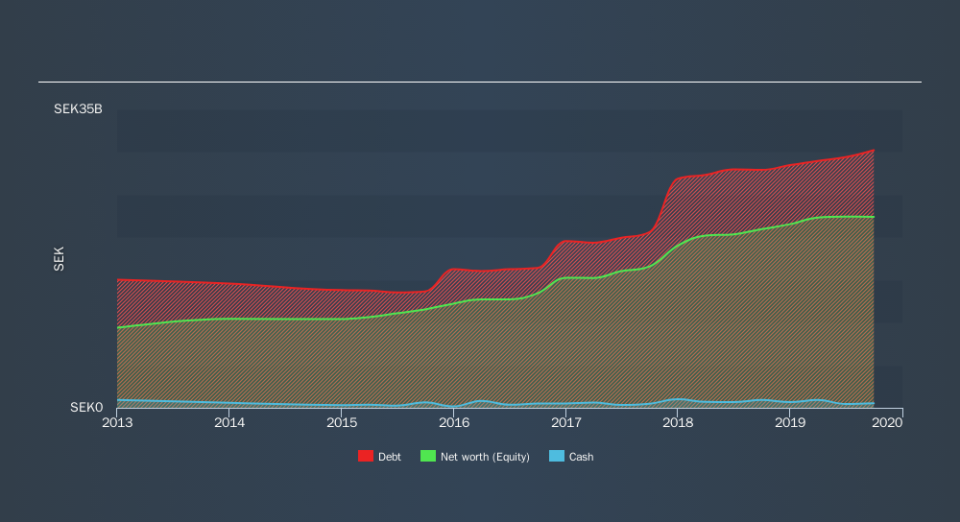Pandox (STO:PNDX B) Takes On Some Risk With Its Use Of Debt

The external fund manager backed by Berkshire Hathaway's Charlie Munger, Li Lu, makes no bones about it when he says 'The biggest investment risk is not the volatility of prices, but whether you will suffer a permanent loss of capital. So it might be obvious that you need to consider debt, when you think about how risky any given stock is, because too much debt can sink a company. Importantly, Pandox AB (publ) (STO:PNDX B) does carry debt. But is this debt a concern to shareholders?
What Risk Does Debt Bring?
Debt is a tool to help businesses grow, but if a business is incapable of paying off its lenders, then it exists at their mercy. If things get really bad, the lenders can take control of the business. However, a more usual (but still expensive) situation is where a company must dilute shareholders at a cheap share price simply to get debt under control. By replacing dilution, though, debt can be an extremely good tool for businesses that need capital to invest in growth at high rates of return. The first thing to do when considering how much debt a business uses is to look at its cash and debt together.
See our latest analysis for Pandox
What Is Pandox's Net Debt?
As you can see below, at the end of September 2019, Pandox had kr30.2b of debt, up from kr27.9b a year ago. Click the image for more detail. And it doesn't have much cash, so its net debt is about the same.
A Look At Pandox's Liabilities
The latest balance sheet data shows that Pandox had liabilities of kr6.79b due within a year, and liabilities of kr32.5b falling due after that. Offsetting these obligations, it had cash of kr530.0m as well as receivables valued at kr520.0m due within 12 months. So it has liabilities totalling kr38.3b more than its cash and near-term receivables, combined.
When you consider that this deficiency exceeds the company's kr37.3b market capitalization, you might well be inclined to review the balance sheet intently. Hypothetically, extremely heavy dilution would be required if the company were forced to pay down its liabilities by raising capital at the current share price.
We measure a company's debt load relative to its earnings power by looking at its net debt divided by its earnings before interest, tax, depreciation, and amortization (EBITDA) and by calculating how easily its earnings before interest and tax (EBIT) cover its interest expense (interest cover). This way, we consider both the absolute quantum of the debt, as well as the interest rates paid on it.
Weak interest cover of 2.0 times and a disturbingly high net debt to EBITDA ratio of 9.5 hit our confidence in Pandox like a one-two punch to the gut. The debt burden here is substantial. On a slightly more positive note, Pandox grew its EBIT at 13% over the last year, further increasing its ability to manage debt. When analysing debt levels, the balance sheet is the obvious place to start. But ultimately the future profitability of the business will decide if Pandox can strengthen its balance sheet over time. So if you're focused on the future you can check out this free report showing analyst profit forecasts.
But our final consideration is also important, because a company cannot pay debt with paper profits; it needs cold hard cash. So we clearly need to look at whether that EBIT is leading to corresponding free cash flow. Over the most recent three years, Pandox recorded free cash flow worth 67% of its EBIT, which is around normal, given free cash flow excludes interest and tax. This free cash flow puts the company in a good position to pay down debt, when appropriate.
Our View
While Pandox's interest cover makes us cautious about it, its track record of managing its debt, based on its EBITDA, is no better. But on the brighter side of life, its conversion of EBIT to free cash flow leaves us feeling more frolicsome. When we consider all the factors discussed, it seems to us that Pandox is taking some risks with its use of debt. While that debt can boost returns, we think the company has enough leverage now. Over time, share prices tend to follow earnings per share, so if you're interested in Pandox, you may well want to click here to check an interactive graph of its earnings per share history.
If, after all that, you're more interested in a fast growing company with a rock-solid balance sheet, then check out our list of net cash growth stocks without delay.
We aim to bring you long-term focused research analysis driven by fundamental data. Note that our analysis may not factor in the latest price-sensitive company announcements or qualitative material.
If you spot an error that warrants correction, please contact the editor at editorial-team@simplywallst.com. This article by Simply Wall St is general in nature. It does not constitute a recommendation to buy or sell any stock, and does not take account of your objectives, or your financial situation. Simply Wall St has no position in the stocks mentioned. Thank you for reading.


